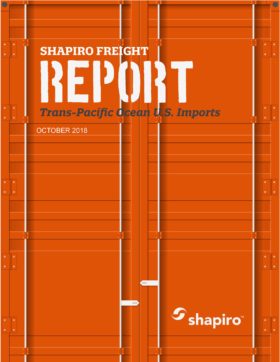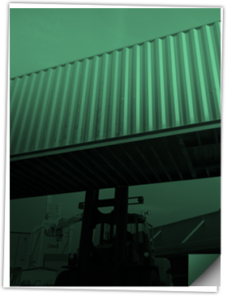Featured Headlines:
CBP Attempting to Address Unlawful E-Commerce Imports
Modernized Minimum Security Criteria for CTPAT to Take Effect 2019
Labor Agreement Reached for East and Gulf Coasts
Low Sulfur Emissions Rule Set to Change, Adding to an Already High Bunker Cost for Carrier
Aftermath of the Brazilian Trucker Strike
Amazon 'Storefront' Initiative to help E-Commerce focus with assisting U.S. sellers
Challenges at the Port of Los Angeles-Long Beach with Chassis and the Return of Empty Containers
Hapag-Lloyd Invests in East African Markets
Southern States’ Chassis Pool Revisited
CBP Attempting to Address Unlawful E-Commerce Imports
As e-commerce business continues to boom, Customs and Border Protection (CBP) has noted the need for enhanced security measures, especially surrounding the lawful declaration of de minimis value.
CBP has witnessed a staggering increase in large shipments being broken down and then imported into the U.S. from both Canada and Mexico, with the former being the most egregious offender, under the guise of de minimis. The majority of this illicit behavior is occurring with full containers originating in China. These shipments are sent to Canada where they are deconsolidated and then sent to the U.S. in truckloads that are comprised of thousands of small packages, each of which is specifically engineered to qualify for de minimis.
In light of these offenses, commencing on January 1st, 2019, CBP will require all Canadian truckers to file advance manifests. Providing further insight into the seriousness of the situation, Robert E. Perez, Deputy Commissioner of the CBP, has stated that, “We’re about ready to roll up our sleeves and lock ourselves in a room like we did with CTPAT. We’re getting close to doing the same with e-commerce.”

Modernized Minimum Security Criteria for CTPAT to Take Effect 2019
The new Minimum Security Criteria (MSC) stems from over 16 years of operational analysis in supply chain security, including over 30,000 CTPAT validations and revalidations.
The MSC is the result of a collaborative effort between the MSC Working Group (WG) and the Commercial Customs Operations Advisory Committee (COAC), which was established in early 2016 to review and discuss CBP proposals for the MSC.
The updated MSC is made up of 3 Focus Areas and 12 Security Criteria Categories.
| 3 Focus Areas | 12 Security Criteria Categories |
| Corporate Security | Security vision and Responsibility (New) |
| Risk Assessment | |
| Business Partner Requirements | |
| Cybersecurity (New) | |
| Transportation Security | Conveyance and IT security |
| Seal Security | |
| Procedural Security | |
| Agricultural Security (New) | |
| People & Physical Security | Physical Access Controls |
| Physical Security | |
| Personnel Security | |
| Education, Training and Awareness |
CBP continues to solicit objective, actionable and specific feedback on the proposed MSC. Comments are due by October 23rd, 2018. Feedback can be submitted via the “Feedback Form” in the CTPAT Portal Document Library.
CBP will review the feedback and recommendations, with plans to implement the MSC in a four-phase approach beginning in 2019.

Labor Agreement Reached for East and Gulf Coasts
As featured in our September Shap Talk, the International Longshoremen’s Association (ILA) and the United States Maritime Alliance (USMX) agreed on a 6 year contract extension that went into effect on September 30th, 2018. Our previous article focused on the role of automation, or lack thereof, in the new contract, while this piece will center on the human capital component of the agreement.
Harold Daggett, President of the ILA, has proclaimed this new deal to be the best contract in his 50+ year career with the ILA. Pier operators worked closely with the ILA to preserve and protect the benefits and salaries of the ILA workers.
The new contract provides members with a $1 per hour increase in base pay for the next four of six years and it increases ILA workers’ share of container royalties to $104 million.The new contract also sets aside significantly more money to contribute to the retirement plan for workers.
Both employers and ILA laborers learned valuable lessons from the delay of contract negotiations for West Coast labor in 2014-2015, which resulted in significant cargo shifts to Gulf and East Coast ports. By ratifying the agreement quickly and with no delays, the East and Gulf Coast port officials hope to retain this gain in market share that they have been enjoying over the last 4 years.

Low Sulfur Emissions Rule Set to Change, Adding to an Already High Bunker Cost for Carrier
The rising cost of fuel is a hot topic among shippers, BCO’s and NVO’s as container lines are preparing to comply with stricter low-sulfur emissions regulations. Beginning January 1st, 2020 carriers will be required to meet the International Maritime Organization’s (IMO’s) mandate of reducing sulfur emissions from the current allowance of 3.5%, to a new benchmark of 0.5%.
The new low-sulfur emissions regulations are likely to put carriers in a difficult place financially, as they will need to account for the increased operational costs of shifting to cleaner forms of fuel.
Some pundits feel that the new ruling will add billions of dollars to the annual container shipping industry’s fuel bill. They operate under the belief that the cost of low-sulfur fuel needed to meet this new mandate will be about 50% higher than the cost of currently utilized fuel types. However, new, cleaner fuel types are still being developed, but won’t be finished until 1st or 2nd quarter of 2019. The range of estimated cost increases to carrier operations is rather extensive.
Thus far, carriers have devised two viable options to reduce emissions. The first, and most obvious, calls for a switch to Low Sulfur Fuel Oil (LSFO), but there are issues surrounding availability and supply. Using the LSFO option would mean ships also have to organize routes depending on the availability of specific types of fuel. This may not be a concern at major bunker ports, but smaller ports may have a more limited range of supply. The second option to lessen emissions revolves around retrofitting scrubbers to vessel exhaust systems as a means of removing excess sulfur emissions, which seems more viable but may not lead to a significant enough reduction.
With average bunker fuel prices through August 2018 having increased by 43.7% when compared to the same quarter last year, fuel continues to become a steep bill for the carriers. It is highly conceivable that the carriers will try to pass these costs on to forwarders, shippers and BCO’s.
The primary criticism among shippers is the lack of transparency on how fuel costs are calculated by the carriers. Numerous shippers feel that carriers should be urged to share their methods of calculating BAF to ensure calculations are being used as a legitimate means of recouping bunker costs and not as a means of additional revenue generation.

Aftermath of the Brazilian Trucker Strike
In May 2018, the Brazilian trucker strike blocked roads for 10 days until Brazilian President, Michael Temer, inked a deal that provided truckers with significant reductions in diesel fuel prices, among other favorable arrangements.
The strike occurred throughout Brazil’s peak season, causing port congestion and space issues. This led to delivery delays on all sides of the supply chain, causing shippers and investors to lose confidence.
In reaction to the strike, shippers overbooked space on all departing vessels with the hope that their cargo would eventually get delivered to the port and be able to depart immediately on any available vessel. According to Maersk, shippers usually overbook by 5%, but this number has increased to 200% following the strike. Despite this rampant overbooking, carriers are still reporting a 5% empty space rate per vessel, which is equivalent to 1 empty vessel per month.
The perpetual overbooking carried out by shippers is negatively impacting the market as the rates provided by ocean carriers are driven by availability of space on vessels. If shippers proceed with their “solution” of overbooking vessels, rates will continue to rise and vessels will continue to depart 5% empty, forcing ocean carriers to deny space to suppliers who could actually use it.
Brazilian exports should be appreciating at a premium given that the currency continues to depreciate. However, until a more long-term solution is implemented by shippers and carriers alike, then space issues will continue to prevent Brazil from living up to its full potential as a trading partner.

Amazon 'Storefront' Initiative to help E-Commerce focus with assisting U.S. sellers
There has been a bit of contention surrounding Amazon’s focus on U.S. businesses this year, stemming from both the current political administration and internal Fulfillment by Amazon (FBA) sellers, who are feeling the impact of international sellers operating on the Amazon U.S. online sales platform. Amazon has been working to counter these notions in several ways.
Earlier this year, Amazon conducted an internal study that highlighted their positive impact on small and medium sized businesses that sell on the Amazon platform in the U.S. Just this past month, in September, Amazon launched their ‘Storefront’ web portal. Similar to the design of Amazon Launchpad, which focuses on tech startups, Storefront highlights products that originate from U.S. businesses that sell on Amazon.
The largest worry facing U.S. consumers is that the money they are spending online is hurting the economy, a narrative that is bolstered by both the administration’s ‘America First’ campaign and frequent news of brick and mortar closures. Storefronts is hoping to mix the best of both worlds and allow Amazon shoppers to feel and see that their purchasing power is aiding U.S. businesses.
The other advantage of Storefronts is that U.S. based businesses are being actively promoted on the portal. The website is hosting written articles and video interviews with business owners to help buyers get to know owners, all while giving the online buyers the ‘local shop’ feel that comes with being a regular patron at a community store. Amazon is also broadcasting its first-ever television commercial advertisement as a means of demonstrating its commitment to the program.

Challenges at the Port of Los Angeles-Long Beach with Chassis and the Return of Empty Containers
Chassis shortages and substantial complications with the returning of empty containers have created major challenges for those doing business at the Port of Los Angeles-Long Beach. Many shippers are experiencing a significant up-tick in per diem charges stemming from the late return of equipment.
Weston LaBar, CEO of Harbor Trucking Associated, commented, “the terminal congestion that results from the chassis dislocations and inability to return empty containers is causing truckers to miss their appointment windows and is significantly reducing the number of dual transactions the drivers can make.”
Recent statistics from the JOC paint a rather severe picture for the U.S.’s largest port complex. Five years ago, approximately 4 in 5 drayage loads reflected an export delivery coupled with the pickup of an import load. Today this number is down to about 1 in 5 loads.
The Port of Los Angeles-Long Beach hopes to deliver improvements to the existing equipment issues through the Port Information Portal (currently under development), which will provide a stronger platform for those in the local community to more effectively exchange essential information. Greater efficiencies in vehicle flow in and out of terminals are also being sought through the implementation of a variety of trucker appointment systems.

Hapag-Lloyd Invests in East African Markets
Hapag-Lloyd is continuing to invest in the growing markets of East Africa, increasing service to a region whose countries lead the African continent in growth.
East African countries, particularly Kenya, are experiencing significant increases in both imports and exports, supported by public infrastructure investments. Kenya has seen its GDP grow by an average of 6% over the past two years, with exports of coffee, tea, vegetables, fruits and textiles driving export growth and imports of electronics and machinery accounting for import growth.
Since April of this year, Hapag-Lloyd has operated the East Africa Service (EAS) as a dedicated service to the region with weekly sailings from Jeddah, Saudi Arabia to Mombasa, Kenya and Dar es Salaam, Tanzania. The early success of this new service has prompted the steamship line to adjust the service with a new “EAS2” service this month, which will include a weekly connection to the Indian ports of Nhava Sheva and Mundra, and the U.A.E. ports of Khor Fakkan and Jebel Ali, in favor of Jeddah. Hapag has cited the success of the new service as a sign of the economic potential of Kenya, stating that overall vessel utilization had surpassed expectations. The steamship line is also investing in inland transportation to other sub-Saharan African countries, offering routings to Burundi, Rwanda, Democratic Republic of Congo, Zambia, and Uganda via the new service.
In light of Section 301 tariffs, are you exploring sourcing alternatives? If so, please contact your Shapiro global logistics team today to learn more about your logistics options and to obtain quotes for a variety of services to better understand the landed cost implications of your alternatives.
Southern States’ Chassis Pool Revisited
As previously featured in the August edition of Shap Talk, the Southern States Chassis Pool (SSCP) was approved by the Federal Maritime Commission (FMC) in late July of this year and, thus far, has been touted as a major success.
Just as a quick recap, the North American Chassis Pool Cooperative (NACPC), a trucker-founded chassis provider, will own and operate the SSCP, which will allow truckers/shippers to pay a flat rate for chassis usage, regardless of the equipment provider. The pool will cover port and terminals in Alabama, Florida, Georgia, North Carolina, South Carolina and Tennessee. Ports in Wilmington, North Carolina, and Jacksonville, Florida are eligible to join the pool, but have not yet decided to do so.
Shapiro has already met with representatives of the SSCP and will utilize the new pool when applicable to provide customers with greater cost savings and more efficient moves.

Employee of the Month
As previously featured in Shap Talk, Shapiro has been sharing with you the names of employees who have been recognized for their exceptional efforts and contributions to our Company. At Shapiro, we continually work to develop, challenge, and inspire all of our employees to grow individually and with the Company.
This month, we would like to recognize Melinda King, Import Manager in Baltimore, for her outstanding performance and contributions.
We encourage you to provide us with employee feedback! Please email us at [email protected].
Freight Report
This high-level, monthly review of the U.S. import freight market provides key insights into the tumultuous world of international shipping. From carrier alliances to labor strikes, Shapiro covers the pertinent information logistics managers need to know. Check back monthly to ensure you don’t miss key industry insights!
Twin Peaks? Are We Set-up for a Second Spike?
Based on what we read in the press and hear “on the street,” U.S. importers are forming two radically different expectations for Transpacific shipping realities for Oct-Dec 2018.
Number One Theory: To circumvent the announced Jan 1, 2019 escalation in tariffs, the traditional winter slack season will be replaced with an extension of the Aug-Sept peak. This implies the continuation of current rate levels and space shortages for the foreseeable future…




